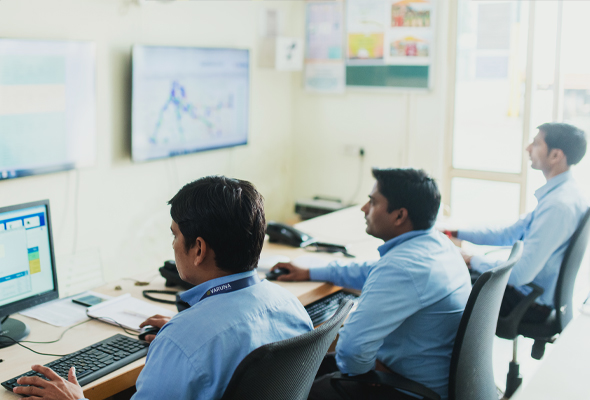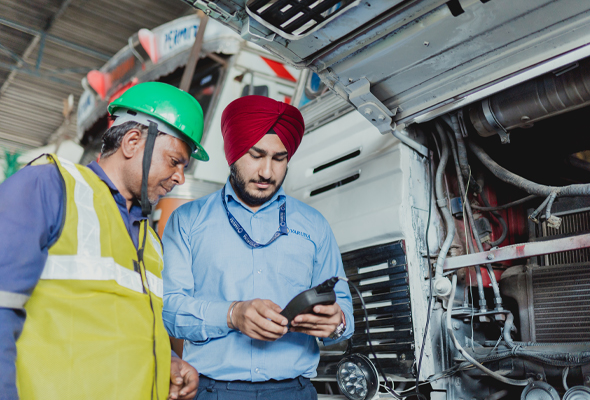Technology is altering the way industries operate today. Many industries and sectors are now adopting advanced technologies including 5G, IoT, AI, machine learning, etc. to improve their processes, resulting in high productivity and efficiency. This also holds true for 3PL, where the use of technology is resulting in more transparency, visibility and collaboration among supply chain participants. A recent 2021 report[1] highlights that more than half of the shippers (52%) and 3PLs (63%) feel that 5G technology is either moderately or critically important. The report further states how 3PLs are using different technologies to enhance their operations - providing data using real-time analytics to clients in 50% or more of their supply chain services, investing in IoT to ‘improve workforce productivity; real-time decision making and creating a competitive differentiator,’ using cloud technology to enhance ‘transportation management systems followed by warehouse management systems.’

A 2019 report highlighted that 94% of shippers concur that IT capabilities are necessary for 3PL expertise, and 56% of shippers acknowledged that they are satisfied with 3PL IT capabilities.[2]
Real-time updates help 3PL keep track of their vehicles as well as prevent and manage delays. This ensures smooth and efficient deliveries. Many companies are increasingly using technologies like IoT, AI and machine learning to enhance their transportation management systems and determine the arrival time windows or potential delays and resolve them swiftly.
Varuna Group, for instance, has a centralised Control Tower and an IoT-enabled tracking dashboard that operates on automated vehicle-based notifications in real-time to monitor the entire fleet. They also have GPS installed in all vehicles to track and manage them along with a 24X7 control room for monitoring vehicle movement. This enables the company to track all potential delays and challenges.
Effective communication and collaboration are key for any business to be successful, including 3PL logistics companies in india. Companies with ineffective internal and external communication often face obstacles in their day-to-day operations. These issues not only hamper the daily functioning but also the productivity of the company. Automating businesses helps companies integrate new and existing customers as well as trading partners and suppliers with minimal disruptions.
V-Manage, a mobile app developed by Varuna Group helps the company’s on-ground team to manage responsibilities seamlessly. Varuna Group’s V-Connect is an internal app for on-demand sourcing of vehicles from a pre-approved fleet for spot indents.
Customer satisfaction is of prime importance for any business. Therefore, it is essential to ensure clear visibility and communication so customers’ needs and demands are met without any delays or mishaps. 3PLs can use real-time updates and tracking systems to keep their customers updated. This will further help 3PLs build trust with their customers as well as strengthen their credibility.
Many companies also build in-house apps and/or devices to keep their customers updated. For instance, V-Track, Varuna Group’s in-house app helps customers track shipments and access order history. The company also provides polygon geofencing for efficient vehicle tracking & complete visibility.

Mechanical failures and repairs of vehicles can be expensive for 3PLs. They not only put financial strain on companies but also affect daily operations and productivity. Many companies are now leveraging technologies such as IoT sensors to help fleet managers execute preventive maintenance as well as machine learning algorithms for disruption management.
Varuna Group has a well-defined SOP for carrying out the activities on Fleet vehicles and Pilots. Their IT-enabled vehicle maintenance programme not only tracks and monitors all the data of maintenance, generates all service schedules and PM schedules but also caters to the Tyre Management System Maintenance. This programme is integrated with the ERP, which is further integrated with GPS for all tracking, health monitoring etc. The company also uses 5 world-class MRO hubs certified by OEMs as well as a national service network for on-road repair & recovery within 4 hours.
While 3PLs are actively engaging with technology and improving their processes and functions, there is much more in store for the 3PL Third Party Logistics companies. With the ever-changing tech scenario, 3PLs can strive to better themselves using the upcoming trends and technologies.
A 2020 report by Global Market Insights Inc. highlighted that the 3PL Third Party Logistics market size exceeded ?74 crores in 2019 and is expected to grow at 9% CAGR between 2020 and 2026.[5] With the access and exposure to new technologies and trends, many 3PL will introduce technology in all aspects of their functioning in the coming years. One will witness the integration of technological tools and trends like the use of blockchain to integrate different components into a single platform, enhancing visibility; drones and robotics to make small deliveries and reducing labour-intensive work. This will open up new opportunities and horizons for the sector to innovate, experiment and grow.
However, it is also important to note that the growth and innovation within the 3PL industry are not yet balanced. While some big leaders of the space are already on track to disrupt the market, others are yet to introduce basic technologies to improve their operations. The coming years, though, will definitely provide more opportunities and space for innovation and growth for all.
According to Vivek Juneja, Founder and MD of Varuna Group, 3PL is “poised for robust, sustained growth in the upcoming months with the increasing adoption of technology and companies taking a digital-first approach. As customer expectations evolve constantly, companies must evolve alongside this to avoid becoming redundant.”
Contact us today for detailed insights on how Varuna Group can support your business.
[1] NTT DATA, Penn State University, Penske Logistics, 2021. 2022 Third-Party Logistics Study. [online] Available at:
[2] Infosys Consulting, Penn State University, Penske Logistics, 2019. 2020 Third-Party Logistics Study. [online] Available at:
[3] Fedex.com. 2019. Technology and Innovation Policy Perspectives | FedEx. [online] Available at:
[4] DHL. 2019. DHL Express Launches Its First Regular Fully-Automated and Intelligent Urban Drone Delivery Service. [online] Available at:
[5] Global Market Insights Inc. 2021. Third-Party Logistics Market Share | 3PL Industry Size Report 2026. [online] Available at:
AI, IoT, cloud-based TMS/WMS, blockchain, and automation tools are widely used to boost efficiency and transparency in 3PL operations.
Real-time visibility helps businesses track shipments, reduce delays, improve inventory control, and ensure customer satisfaction.
Yes, by optimizing routes, automating repetitive tasks, and improving demand forecasting, technology significantly reduces logistics costs.
The future lies in AI-driven supply chains, predictive analytics, autonomous vehicles, and end-to-end digital integration for smarter logistics.
Drive efficiencies throughout your supply chain with our technology-enabled services